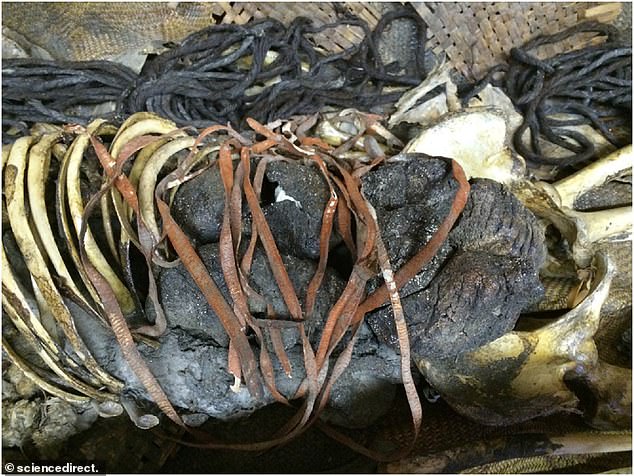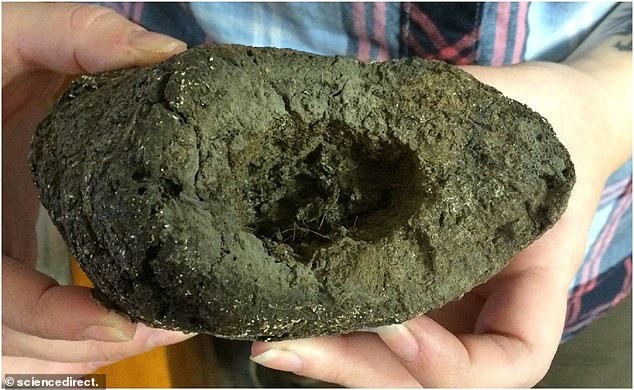Constipation: In 1937 near the junction of the Rio Grande and Pecos Rivers in Texas, Guy Skiles found a skeleton in a cave on his property, Mile Canyon. The property is filled with caves and canyons full of archaeological artifacts which Skiles added to his own museum.
No one has excavated here other than the few scientists that Skiles and his son, Jack, allowed in. The fourteen hundred year old skeleton was naturally mummified in the hot and dry desert sands and had some hair and bone tissue left on his body.
The skeleton was moved between several institutions until 2003 when Karl Reinhard, a professor in the School of Natural Resources at the University of Nebraska–Lincoln revisited the mummy using a newer approach, scanning electron microscopy.

With this, he was able to determine that the man died because of blockage, constipation in his colon leaving 2.6 pounds of feces still in his colon and a large amount of undigested material in his intestines. Because of this, the man was unable to process food through his body and suffered from malnourishment.
The study also found that the man subsisted on grasshoppers in the few months before his death. According to sciencedirect.com, the undigested grasshoppers had had their legs removed and only the meaty parts were eaten.
As the man would have had so much pressure in his abdomen because of constipation he probably wouldn’t have been able to care for himself and scientists believe this may be one of the first examples of palliative care.
The condition is called megacolon and according to Reinhard “In addition to being high in protein (the grasshoppers), it was pretty high in moisture so it would have been easier for him to eat in the early stages of his megacolon experience.”
https://www.youtube.com/watch?v=suGfRKXHhYI
Megacolon is caused by Chagas disease, a parasitic infection caused by Trypanosoma cruzi, and spread by blood sucking triatomine bugs according to cdc.gov. The bugs, which usually bite when the victim is sleeping, leave feces near the wound caused by the bite and the trypomastigotes enter the hosts and invade the surrounding cells.
The trypomastigotes morph into intracellular amastigotes which multiply by binary fission and then into trypomastigotes which are released as bloodstream trypomastigotes and eventually invade the nerve cells.
If the host is repeatedly bitten, it can cause severe allergic reactions including anaphylactic shock. If one scratches at the bite and then touches a mucous membrane, the infection can be transmitted that way as well.

Reinhard’s research paper found at scielo.br tells us the infection causes loss of nervous activity in the large intestine and the blockage can cause leakage from the enlarged colon resulting in death.
The mummy was found with extensive grave goods including woven mats from fibers of the Dasylirion plant native to the Southwest and stone beads.
The body was wrapped in a cloak of fur and tied with a rope made of animal hair and a long deer hide strap painted red around the torso.
Scientists believe the deer hide held in the distended abdomen. He died between the ages of thirty five and forty five years old and his intestines were so full they pressed against and damaged his spinal column.
Also found in the mummy’s intestines were what was left of a fish, a mouse, a gopher and a Western pipistrelle bat along with the two hundred and fifty grasshoppers and some plant materials. If any of the mammals were not fully cooked this could also lend itself to infection.
While triatomine bugs has been found in Africa, Asia and Australia Trypanosoma cruzi and Chagas disease is extremely rare and is found mostly in the American southwest and northern Mexico and can be found in species such as the grasshopper mouse, the nine-banded armadillo, the Southern Plains wood rat, the Hispid pocket mouse, the Mexican Spiny pocket mouse, opossum and the Western Pipistrelle bat.
Another Article From Us: The Ancient Ghost City Of Ani “the city of a thousand and one churches.”
Reinhard is writing a book, The Handbook of Mummy Studies to be published in 2021 which will discuss the mummy as well as two other cases of mummies who may have received special care before their deaths.
